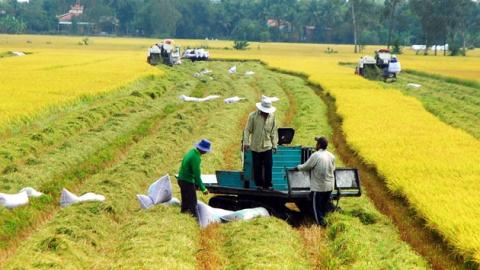
Mekong Delta farmers are happy Prime Minister Nguyen Xuan Phuc has allowed resumption of rice exports from May 1 and export prices are increasing. — VNS Photo Van Chau
Export prices are rising for rice grown in the Cuu Long (Mekong) Delta.
Since Prime Minister Nguyen Xuan Phuc allowed resumption of exports from May 1, prices have risen by VND200,000-400,000 (US$8.5-17) per tonne from late April.
The PM’s decision has made farmers happy and they are taking better care of their rice crop, hoping prices would continue to increase for the summer-autumn crop, Tran Chi Hung, director of the Hau Giang Province Department of Agriculture and Rural Development, said.
The delta has sown more than 750,000 hectares of summer-autumn crop rice.
According to the Hau Giang Sub-Department of Crop Production, the rice has ripened due to favourable weather and the yield is estimated to be seven to eight tonnes per hectare.
Rice growers are in the final tending stages in preparation for the harvest. The expected summer-autumn output in the delta is 8.7 million tons, providing 2.3-2.4 million tonnes for export.
Experts said businesses need to take advantage of the rising export prices. Viet Nam's rice prices are on a par with Pakistan’s, higher than India’s and lower than Thailand’s.
On March 24 Viet Nam capped exports of rice to ensure food security after the COVID-19 pandemic broke out.
It is the world's third largest exporter after India and Thailand. Last year the country exported 6.37 million tonnes worth US$2.81 billion, with its top markets being the Philippines (2.1 million tonnes), Ivory Coast (580,000 tonnes), Malaysia (550,000 tonnes), and China (477,000 tonnes).
Exports in the first two months of this year had topped 890,000 tonnes and fetched $410 million, increases of 27 per cent and 32.6 per cent year-on-year.
According to the Ministry of Industry and Trade, the country is projected to grow 43.5 million tonnes of the grain this year, nearly 30 million tonnes of which will be used for domestic consumption and the rest will be exported. — VNS